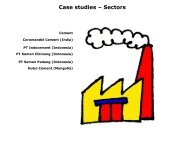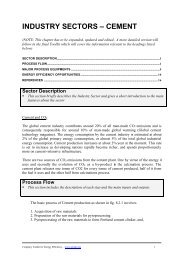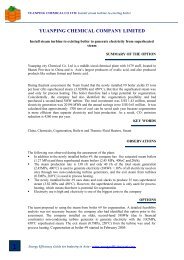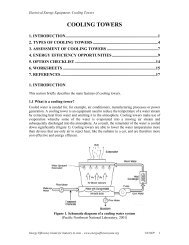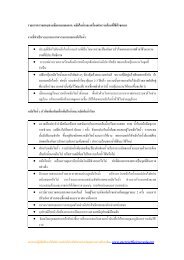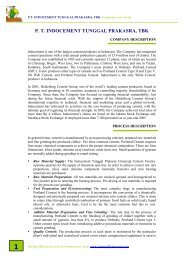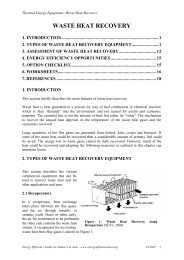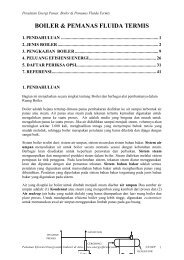Chapter - Fuels and Combustion - RETScreen International
Chapter - Fuels and Combustion - RETScreen International
Chapter - Fuels and Combustion - RETScreen International
Create successful ePaper yourself
Turn your PDF publications into a flip-book with our unique Google optimized e-Paper software.
Thermal Equipment: <strong>Fuels</strong> <strong>and</strong> <strong>Combustion</strong><br />
The ash value is related to the inorganic material or salts in the fuel oil. The ash levels in<br />
distillate fuels are negligible. Residual fuels have higher ash levels. These salts may be<br />
compounds of sodium, vanadium, calcium, magnesium, silicon, iron, aluminum, nickel, etc.<br />
Typically, the ash value is in the range 0.03 - 0.07 %. Excessive ash in liquid fuels can cause<br />
fouling deposits in the combustion equipment. Ash has an erosive effect on the burner tips,<br />
causes damage to the refractories at high temperatures <strong>and</strong> gives rise to high temperature<br />
corrosion <strong>and</strong> fouling of equipments.<br />
2.1.10 Carbon Residue<br />
Carbon residue indicates the tendency of oil to deposit a carbonaceous solid residue on a hot<br />
surface, such as a burner or injection nozzle, when its vaporizable constituents evaporate.<br />
Residual oil contains carbon residue of 1 percent or more.<br />
2.1.11 Water Content<br />
The water content of furnace oil when it is supplied is normally very low because the product<br />
at refinery site is h<strong>and</strong>led hot. An upper limit of 1% is specified as a st<strong>and</strong>ard.<br />
Water may be present in free or emulsified form <strong>and</strong> can cause damage to the inside surfaces<br />
of the furnace during combustion especially if it contains dissolved salts. It can also cause<br />
spluttering of the flame at the burner tip, possibly extinguishing the flame, reducing the flame<br />
temperature or lengthening the flame.<br />
Typical specifications of fuel oils are summarized in the Table below.<br />
Table 4. Typical specifications of fuel oils (adapted from Thermax India Ltd.)<br />
Properties<br />
Fuel Oils<br />
Furnace Oil L.S.H.S L.D.O<br />
Density (Approx. 0.89 - 0.95 0.88 - 0.98 0.85 - 0.87<br />
g/cc at 150C)<br />
Flash Point (0C) 66 93 66<br />
Pour Point (0C) 20 72 18<br />
G.C.V. (kCal/kg) 10500 10600 10700<br />
Sediment, % Wt.<br />
0.25 0.25 0.1<br />
Max.<br />
Sulphur Total, % Up to 4.0 Up to 0.5 Up to 1.8<br />
Wt. Max.<br />
Water Content, %<br />
1.0 1.0 0.25<br />
Vol. Max.<br />
Ash % Wt. Max. 0.1 0.1 0.02<br />
2.1.12 Storage of Fuel oil<br />
It can be potentially hazardous to store furnace oil in barrels. A better practice is to store it in<br />
cylindrical tanks, either above or below the ground. Furnace oil that is delivered may contain<br />
dust, water <strong>and</strong> other contaminants.<br />
Energy Efficiency Guide for Industry in Asia – www.energyefficiencyasia.org ©UNEP 4



